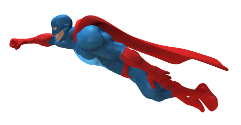The Leap from Comic
Books to Graphic Novels
© 2009 Roland Mann

What are Graphic Novels and should I
keep my kids from reading them? Part 2
For nearly as long as there have been comics, there have been
"underground" comics, some of which are hardcore pornography.
Underground, or "independent comics" as they're often called in the
industry, began to flourish in the '70s with the advent of the comic
specialty shop—a store which specializes in selling comics and
comic-related material. It is estimated there were 5,000 comic shops in
the United States in the middle '90s before the comic book bust. Now
estimates suggest well less than half that number.
Graphic novels grew out of the sales successes of The Dark Night and
Watchmen.
Over the years, publishers found that mainstream bookstores
like Waldenbooks and Barnes and Noble would shelve a graphic
novel—printed like a traditional book—in their stores while they were
less inclined to find rack space for magazine-style comics. So
publishers began to search frantically for material to release in the
graphic novel format.
Graphic novels then can be a wide assortment of material. The term
"graphic novel" is an umbrella term which refers to any comic book
style story printed in a squarebound format. Much of the material
published is simply reprinted comic book stories collected together to
present a longer story; generally, they contain 80 or more pages of
comics. Publishers often seek a new audience at the bookstores while
trying to encourage longtime comic readers to buy the "collected
stories."
Graphic novels also include "manga," another popular sub-genre. "Manga"
is simply a term used to describe Japanese-style artwork in the comics
or graphic novels and should carry neither a positive nor negative
connotation. Manga, like American-style art, has both good stories and
stories to avoid.
Regrettably, comic companies did away with using the Comics Code
Authority, a "seal of approval" indicating that the comics were okay
for kids to read. When I began editing comics in the early '90s, we
followed the code. By the time I left Marvel in '96, we didn't.
So if parents can no longer trust the Marvel and DC brands, how can
they know which graphic novels are okay for kids to read? The answer is
both simple and frustrating: parents must monitor what their kids read.
n the same way we don't let them watch television shows or movies
without knowing what they're seeing, we shouldn't let them read a
graphic novel without first reading it—or at least skimming it.
Currently, there are few websites devoted to illuminating
age-appropriate material. The occasional blogger will recommend a few
select titles, but a good starting point is
http://comicsintheclassroom.net/.
Trusted friends can also be the source of confidence regarding graphic
novel reading material.
This article does not intend to suggest there is no good material to be
found in graphic novels. Quite the opposite. Comic storytelling is a
tried and true story medium and has a proven track record of drawing
kids into reading. We just have to be careful which graphic novels we
let them read . . . we need to be parents!
Roland Mann is
currently a freelance writer living in Oxford, Mississippi. Roland is a
writer and former editor for Malibu and Marvel comics, a former
University instructor, and a former newspaper editor. His latest
graphic novel, an adaptation of The Adventures of Huckleberry Finn, may
be ordered from www.campfire.co.in for free worldwide
delivery. He has completed two novels, both of which are "under
consideration" by people who can publish them. One of them is also
being considered by a local film company as a possible screenplay. He
blogs regularly at www.rolandmann.wordpress.com.